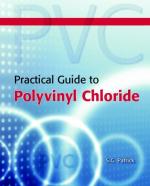|
This section contains 1,310 words (approx. 5 pages at 300 words per page) |

|
Overview
Polyvinyl chloride (pol-ee-VYE-nul KLOR-ide) is also known as PVC, vinyl, chlorethylene homopolymer, and chlorethene homopolymer. It is the third most commonly produced plastic in the United States, exceeded only by polyethylene and polypropylene. It is offered commercially in a variety of formulations, usually as a white powder or colorless granules. The compound is resistant to moisture, weathering, most acids, fats and oils, many organic solvents, and attack by fungi. It is easily colored and manufactured in a variety of forms, including sheets, films, fibers, and foam.
Key Facts
Other Names:
See Overview.
Formula:
-[-CH2CHCl-]-n
Elements:
Carbon, hydrogen, chlorine
Compound Type:
Organic polymer
State:
Solid
Molecular Weight:
Varies
Melting Point:
Decomposes at 148°C (298°F)
Boiling Point:
Not applicable
Solubility:
Insoluble in water; soluble in tetrahydrofuran, dimethyllformamide, dimethylsulfoxide
Polyvinyl chloride was first discovered accidentally in 1835 by the French physicist and chemist Henry Victor...
|
This section contains 1,310 words (approx. 5 pages at 300 words per page) |

|


